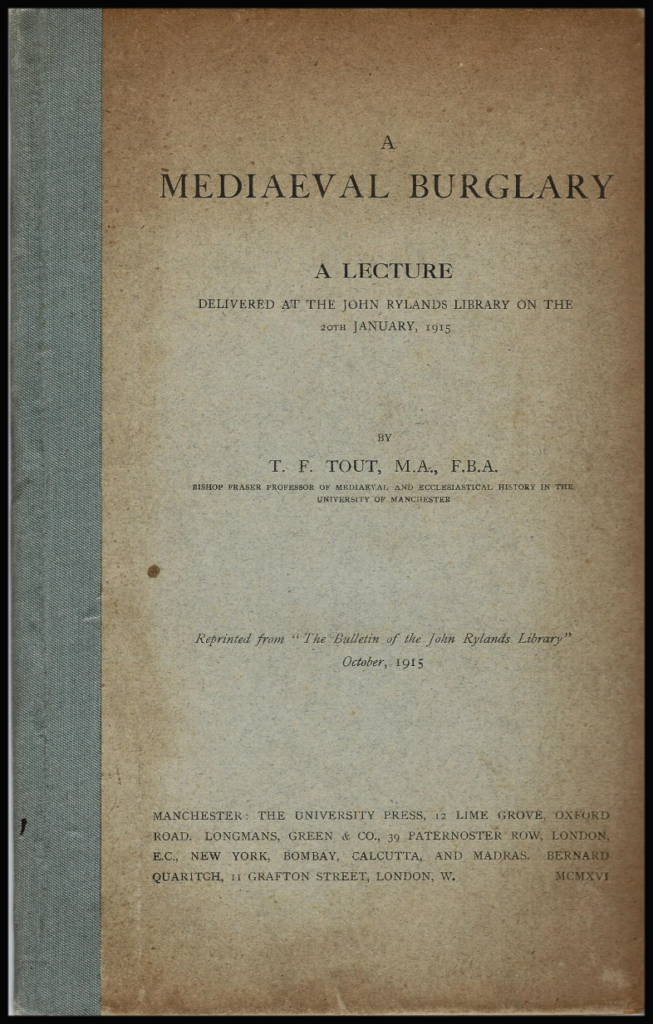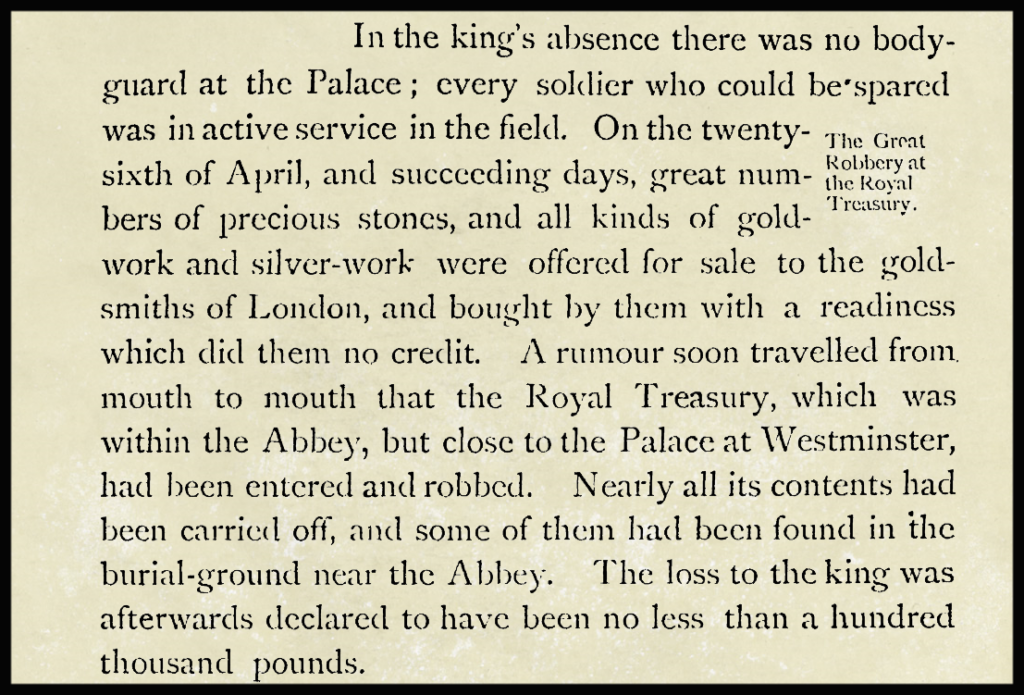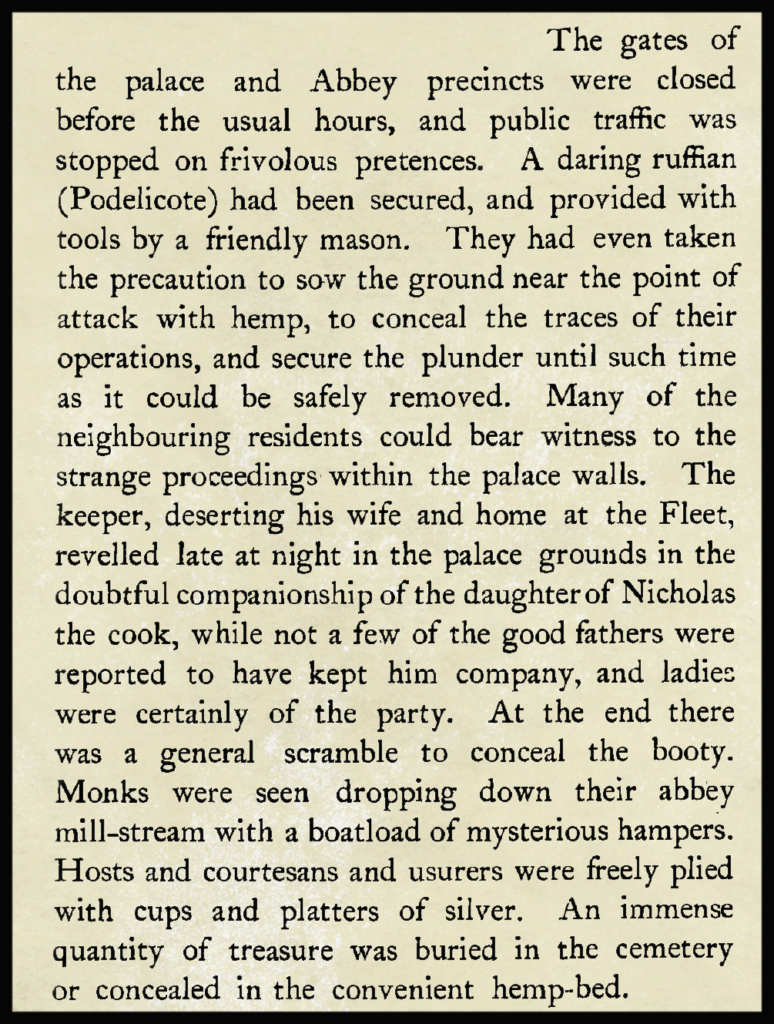In 1915 T. F. Tout gave a lecture at the John Rylands library on a great crime. It was the burglary of the treasury in the King’s Wardrobe in the abbey at Westminster on April 24, 1303. 1 Tout examines how the story has come down to us and lays out the plot in detail. Why is this event, so remote and lost to history, intriguing? As I read this story I wondered: Where was the king? Where were the guards? And most curious, why was the King’s treasure in a wardrobe? These questions led me on an interesting journey in historiography and ancient sources.
To summarize, the burglary took place in late April 1303. Edward I was in Scotland at war with William Wallace for the control of the northern Scottish territories. When the King traveled it was customary for the national treasury to follow in the Wardrobe along with the rest of his retinue. On this occasion the treasure was deposited in a room under the chapter house of Westminster Abbey designated to house the Kings Wardrobe. We do not know the reason for this change in plans, but it was clear that there was an opportunity ripe for the taking. Whether it was with the help of the Monks charged with protecting the treasure or on his own, Richard of Pudlicott (also known as Richard de Podelicote) plotted to take the loot. Depending on the account, on his own or with the help of a gang of thieves, gold, coin, jewels, and other treasure was taken. The local community started to take notice as items begin to appear in the pub and pawn shops being traded by near do wells and prostitutes. Treasures were even found by fishermen in the river Thames. The king was notified, and dozens of people were rounded up, jailed, and placed on trial. Many were hanged. The implicated monks were spared because of Richard’s confession as well as their possible influence with the crown. Richard experienced a most gruesome fate. Eventually the bulk of the hoard was returned to the King.
We are able to know about this rich and deeply layered tale because of the attempts of the monks to absolve themselves participating in the crime. As T. F. Tout noted there were a number of accounts that have survived. One of the most detailed, and in Tout’s estimation, accurate, is the chronicle written by Robert of Reading. 2
Modern accounts of the burglary are traced to published records of English Chronicles starting with Francis Palgrave’s The Antient Kalendars and Inventories of the Treasury of His Majesty’s Exchequer, with other documents illustrating the history of that repository.
Later in the nineteenth century Luke Pike (1873), focused on the trials related to the theft as well as the role of the clergy. But he does uncover why the monks were guarding the treasure and the scope of the theft. 3
Hubert Hall, writing in 1898, was more concerned with the history of the treasury and the role of the wardrobe in English history. He goes into great detail about the how the burglary was committed. He published a plan for the Westminster Abby grounds that Tout reproduced in his lecture.
Hall also examines the evicence implicating the monks and friars.4
Interest has continued to the present time as witnessed by Paul Doherty’s book The great crown jewels robbery of 1303.
As the publisher notes:
This compelling work is an exhilarating tale of cunning deceit, lechery, feisty villains, meddling monks, greedy goldsmiths, and devious pimps and prostitutes. It takes the lid off both the medieval underworld and the assumed piousness of the monastic community.5
So here are the hints to raise your appetite to explore this mystery further. Look into the original documents, read the records in our library and dive deep into the medieval world. There are more paths to follow in the tales recounted here.
—-
DLWA Call Number: DC151 .A58 1997
Worldcat: Link
- Title: The great crown jewels robbery of 1303: the extraordinary story of the first big bank raid in history. London: Constable.
- Author: Paul Doherty
- Language: English
- Setting: English History
DLWA Call Number: HJ1028 .H2 1891
Worldcat: Link
- Title: The Antiquities and Curiosities of the Exchequer, etc. E. Stock: London.
- Author: Hubert Hall
- Language: English
- Setting: English History
DLWA Call Number: Upcomming acqusition
Worldcat: Link
- Title: The Antient Kalendars and Inventories of the Treasury of His Majesty’s Exchequer, with other documents illustrating the history of that repository … collected and edited by Sir Francis Palgrave. London: Printed by C. Eyre and A. Spottiswoode.
- Author: Francis Palgrave
- Language: English, French, Latin
- Setting: English History
DLWA Call Number: HV6943 .A212 1873
Worldcat: Link
- Title: A history of crime in England. [Place of publication not identified]: Smith Elder and Co.
- Author: Luke Owen Pike
- Language: English
- Setting: English History
DLWA Call Number: DA229 .T649 1915
Worldcat: Link
- Title: “A mediaeval burglary”. Bulletin of the John Rylands Library. 2: 348-369.
- Author: T. F. Tout
- Language: English
- Setting: English History
—-
- Tout, T. F. 1914. “A mediaeval burglary”. Bulletin of the John Rylands Library. 2: 348-369. paginated as separate volume pp 3-24
- ibid. pp.22-23
- Pike, Luke Owen. 1873. A history of crime in England
- Hall, Hubert. 1898. The Antiquities and Curiosities of the Exchequer, etc. pp.19-34
- Doherty, Paul. 2005. The great crown jewels robbery of 1303: the extraordinary story of the first big bank raid in history Cover
–DLW






